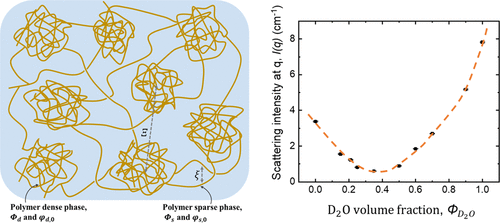当前位置:
X-MOL 学术
›
Macromolecules
›
论文详情
Our official English website, www.x-mol.net, welcomes your
feedback! (Note: you will need to create a separate account there.)
Tough Hydrogels with Dynamic H-Bonds: Structural Heterogeneities and Mechanical Performances
Macromolecules ( IF 5.1 ) Pub Date : 2021-09-20 , DOI: 10.1021/acs.macromol.1c01064 Wei Zhen Lian 1 , Zhi Wei Fan 1 , Kunpeng Cui 2 , Panchao Yin 1 , Junsheng Yang 1 , Han Jiang 3 , Liqun Tang 4 , Taolin Sun 1
Macromolecules ( IF 5.1 ) Pub Date : 2021-09-20 , DOI: 10.1021/acs.macromol.1c01064 Wei Zhen Lian 1 , Zhi Wei Fan 1 , Kunpeng Cui 2 , Panchao Yin 1 , Junsheng Yang 1 , Han Jiang 3 , Liqun Tang 4 , Taolin Sun 1
Affiliation

|
The recently developed tough and self-healing hydrogels, containing a large number of physical bonds, have found widespread applications in bioengineering and soft electronics. Owing to the sophisticated physical interactions and organization, these hydrogels often demonstrate structural heterogeneities, which strongly influence their mechanical performances. Using poly(N,N-dimethyl acrylamide-co-methacrylic acid) hydrogels (P(DMAA-co-MAAc)) with dynamic hydrogen bonds (H-bonds) as a model system, the structural characterization has been carried out in this study using small-angle X-ray scattering (SAXS) and small-angle neutron scattering (SANS) analyses, along with exploring the influence of the structure on the mechanical properties. By systematically tuning the polymer composition, including the monomer fraction and chemical cross-linking density, two different hydrogel regions with distinct mechanical properties were observed: the swollen regions and shrunk regions. The former was mechanically weak, whereas the latter exhibited a tough behavior. Both types of hydrogels were noted to be highly heterogeneous, which results from the nanoscale spatial polymer concentration fluctuations at ∼100 nm scale. Combined with the contrast variation utilizing SANS, the structure parameters, including the polymer volume fraction of the dense and sparse regions, volume fraction occupied in the space, and average correlation length of the long-range and short-range heterogeneous structures, were explored using a scaling model based on a two-phase system composed of the densely and sparsely cross-linked regions. Using in situ SAXS, the microscopic deformation of the tough and shrunk hydrogels was noted to follow the affine deformation, while a significantly non-affine deformation was observed in the swollen hydrogels, which might have led to the different mechanical performances of these materials.
中文翻译:

具有动态 H 键的坚韧水凝胶:结构异质性和机械性能
最近开发的坚韧和自修复水凝胶含有大量物理键,已在生物工程和软电子领域得到广泛应用。由于复杂的物理相互作用和组织,这些水凝胶通常表现出结构异质性,这强烈影响了它们的机械性能。使用聚(N,N-二甲基丙烯酰胺-共聚-甲基丙烯酸)水凝胶(P(DMAA- co-MAAc)) 以动态氢键(H 键)作为模型系统,本研究中使用小角 X 射线散射(SAXS)和小角中子散射(SANS)分析进行了结构表征,同时探索结构对力学性能的影响。通过系统地调整聚合物组成,包括单体分数和化学交联密度,观察到两个具有不同机械性能的不同水凝胶区域:膨胀区域和收缩区域。前者在机械上很弱,而后者表现出强硬的行为。两种类型的水凝胶都具有高度异质性,这是由于纳米级空间聚合物浓度在~100 nm 尺度上波动造成的。结合使用 SANS 的对比度变化,结构参数,包括密集和稀疏区域的聚合物体积分数,空间中所占的体积分数,以及长程和短程异质结构的平均相关长度,使用基于两个的尺度模型进行了探索。由密集和稀疏交联区域组成的相系统。使用原位 SAXS,注意到坚韧和收缩的水凝胶的微观变形跟随仿射变形,而在膨胀的水凝胶中观察到显着的非仿射变形,这可能导致这些材料的不同机械性能。使用基于由密集和稀疏交联区域组成的两相系统的缩放模型进行了探索。使用原位 SAXS,注意到坚韧和收缩的水凝胶的微观变形跟随仿射变形,而在膨胀的水凝胶中观察到显着的非仿射变形,这可能导致这些材料的不同机械性能。使用基于由密集和稀疏交联区域组成的两相系统的缩放模型进行了探索。使用原位 SAXS,注意到坚韧和收缩的水凝胶的微观变形跟随仿射变形,而在膨胀的水凝胶中观察到显着的非仿射变形,这可能导致这些材料的不同机械性能。
更新日期:2021-10-12
中文翻译:

具有动态 H 键的坚韧水凝胶:结构异质性和机械性能
最近开发的坚韧和自修复水凝胶含有大量物理键,已在生物工程和软电子领域得到广泛应用。由于复杂的物理相互作用和组织,这些水凝胶通常表现出结构异质性,这强烈影响了它们的机械性能。使用聚(N,N-二甲基丙烯酰胺-共聚-甲基丙烯酸)水凝胶(P(DMAA- co-MAAc)) 以动态氢键(H 键)作为模型系统,本研究中使用小角 X 射线散射(SAXS)和小角中子散射(SANS)分析进行了结构表征,同时探索结构对力学性能的影响。通过系统地调整聚合物组成,包括单体分数和化学交联密度,观察到两个具有不同机械性能的不同水凝胶区域:膨胀区域和收缩区域。前者在机械上很弱,而后者表现出强硬的行为。两种类型的水凝胶都具有高度异质性,这是由于纳米级空间聚合物浓度在~100 nm 尺度上波动造成的。结合使用 SANS 的对比度变化,结构参数,包括密集和稀疏区域的聚合物体积分数,空间中所占的体积分数,以及长程和短程异质结构的平均相关长度,使用基于两个的尺度模型进行了探索。由密集和稀疏交联区域组成的相系统。使用原位 SAXS,注意到坚韧和收缩的水凝胶的微观变形跟随仿射变形,而在膨胀的水凝胶中观察到显着的非仿射变形,这可能导致这些材料的不同机械性能。使用基于由密集和稀疏交联区域组成的两相系统的缩放模型进行了探索。使用原位 SAXS,注意到坚韧和收缩的水凝胶的微观变形跟随仿射变形,而在膨胀的水凝胶中观察到显着的非仿射变形,这可能导致这些材料的不同机械性能。使用基于由密集和稀疏交联区域组成的两相系统的缩放模型进行了探索。使用原位 SAXS,注意到坚韧和收缩的水凝胶的微观变形跟随仿射变形,而在膨胀的水凝胶中观察到显着的非仿射变形,这可能导致这些材料的不同机械性能。









































 京公网安备 11010802027423号
京公网安备 11010802027423号